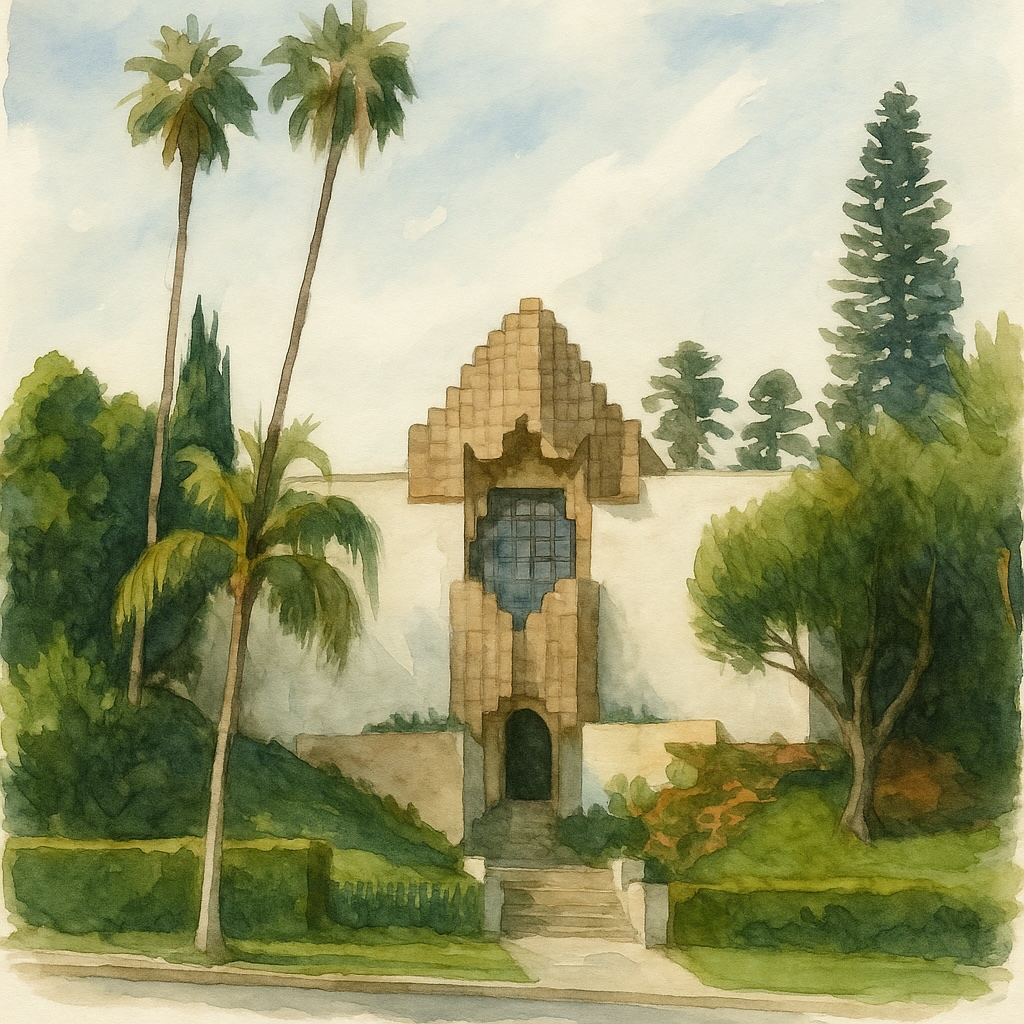A fortress of carved concrete and shadowed courtyards, the Sowden House looks like a set piece for a lost Hollywood epic. Designed by Lloyd Wright in 1926 for artist John Sowden, it has lived many lives: salon for creatives, tabloid lightning rod, near ruin, and carefully revived landmark. What endures is a singular work where architecture, performance, and Los Angeles myth overlap. It is part of a lineage of experimental hillside architecture that includes the Ennis House, whose textile blocks helped shape Los Feliz’s early modern identity.

Quick Facts
Address: 5121 Franklin Ave, Los Angeles, CA 90027
Built: 1926
Architect: Lloyd Wright
Style: Neo Mayan using ornamented concrete textile blocks
Size: Approx. 5600 to 6000 sq ft, typically 4 bd, 5 to 6 ba
Landmark status: National Register of Historic Places 1971, Los Angeles Historic Cultural Monument No. 762 (2003)
Notable owners: John and Ruth Sowden (original), Dr. George Hodel (1945 to 1950), designer Xorin Balbes (restoration 2001), Dan Goldfarb (2018), Nate Daneshgar (2022)
How the Sowden House came to be
Photographer and painter John Sowden wanted a house that could entertain. Lloyd Wright, eldest son of Frank Lloyd Wright, answered with a camera ready composition on Franklin Avenue. Guests compress through a narrow stair and copper gates into a bright open court. That shift from shade to light is intentional. The house is a sequence, not a snapshot, and the courtyard is the stage where the evening actually happens.
Architecture: block by block
Wright uses textile blocks cast with geometric reliefs, a technique that turns the walls into ornament without a separate layer of decoration. The facade steps like a small ziggurat. Inside, four primary wings pinwheel around the court so most rooms face the center. Light moves across the pattern like it would across carved stone. Wright’s approach echoes the sculptural ambitions seen earlier in Moorcrest, where geometry and shadow work together to create theatrical space. The original plan used water as choreography too, with a long reflecting pool and experimental fountains that amplified sound.
Los Feliz in the 1920s and beyond
Los Feliz in the 1920s sat between the boom of Hollywood and the quiet of Griffith Park. Architects were testing new materials and forms while the film industry was inventing modern celebrity. Houses here were often laboratories. That same spirit of experimentation defined the Lovell Health House, which introduced International Style modernism to the hills only a few years later. The Sowden House belongs to that moment. It is historic, but it never stopped being strange in the best way, which is why it keeps appearing in fashion shoots, music videos, and noir adjacent storytelling.
The notorious chapter
From 1945 to 1950 the owner was physician George Hodel. Decades later, allegations tied him to the unsolved Black Dahlia case. He was never charged. The association stuck anyway and changed how the public talked about the house. Today the property is understood first as architecture of record. The lore is a parallel thread that will probably never vanish from the narrative because Los Angeles rarely lets a good myth go.
Decline and revival
Late twentieth century deferred maintenance left the blocks and services tired. In 2001, designer Xorin Balbes purchased the property and led a significant restoration and reimagining: stabilizing blockwork, opening the kitchen, updating baths, and re centering the courtyard with a pool and spa that return water to the heart of the sequence. Purists debated some choices. The practical result was a livable, photogenic landmark that reentered the city’s cultural rotation. The house’s return to prominence paralleled the careful preservation of other major estates, including Greystone Mansion in Beverly Hills.
Ownership timeline
- 1926: Completed for John and Ruth Sowden. Lloyd Wright develops a theatrical courtyard plan with textile blocks.
- 1945 to 1950: Owned by Dr. George Hodel, the period later linked to the home’s darker mythology.
- 1971: Listed on the National Register of Historic Places. Recognition arrives as LA begins to value its modern and revival works.
- 2001: Purchased and restored by designer Xorin Balbes. The project returns the house to use and visibility.
- 2018: Sold to Dan Goldfarb.
- 2022: Sold for approximately 6.16 million dollars to Nate Daneshgar, reflecting ongoing demand for branded architecture in Los Feliz.
On screen and in the culture
The courtyard is effectively a performance chamber with controlled light and high walls, which makes it a favorite for image makers. Alongside the Ennis, Storer, Freeman, and Millard houses, the Sowden House is part of a specific LA language where buildings behave like characters.
Why the Sowden House matters
- Authorship: A signature Lloyd Wright work that pushes the textile block idea beyond surface pattern into full spatial drama.
- Craft: Cast ornament at building scale is rare and labor intensive. Few homes attempt it, fewer maintain it.
- Cultural resonance: A nexus of art, rumor, and preservation that explains why Los Angeles obsesses over its architecture. Its influence stretches across neighborhoods and eras, much like The Cedars, another landmark where design, celebrity, and myth overlap.
Market snapshot
Category defining architecture tends to outrun neighborhood medians over long horizons. The 2018 and 2022 sales underline the same lesson you see with other landmark properties. Scarcity plus authorship plus story is a durable formula when the house photographs this well and functions as a real home.
What it is like inside today
Expect compression, then release. Patterned concrete reads like stone carving. Greenery softens the geometry. The pool makes the court hum at night. Rooms open inward so even private life feels connected to the central stage. It is theatrical without being precious, which is why people remember their first visit years later.
All home images here are artistic illustrations used for education and historical commentary.


